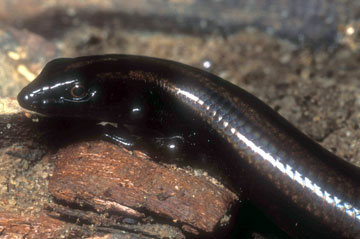Unknown species of lizard discovered in Borneo
Unknown species of lizard discovered in Borneo
Rhett Butler, mongabay.com
December 11, 2006
A previously unknown species of lizard was discovered in Borneo by Chris Austin, assistant curator of herpetology at Louisiana State University’s Museum of Natural Science. The scientific name of the lizard, which was discovered while Austin was conducting field research in Sarawak, will be unveiled in the March 2007 edition of Journal of Herpetology. The discovery comes as Borneo’s rainforests are increasingly endangered by logging, clearing for oil palm plantations for biofuel, and agricultural fires.
Austin, who with colleague Indraneil Das from the Institute of Biodiversity and Environmental Conservation at the Universiti Malaysia Sarawak, found the species while overturning rainforest logs. Immediately he suspected it was a new species but had to go through the process of proving it before anything could be announced.
 The newly discovered lizard, a type of skink, from Borneo. Photo courtesy of Dr. Chris Austin |
“Determining that a species is new to science is a long and laborious process,” said Austin. “Natural history museums and their invaluable collections are critical in that they allow scientists to examine known biodiversity in order to determine a species is new.”
The new lizard is a type of skink. Its closest relative is found in the Philippines.
Austin has since moved onto New Guinea where he may have uncovered further species that may be new to science.
“While we were there, we collected what we think is a new species of snake, a new species of lizard and probably two or three new species of frogs,” he said. “But the process of certifying a new species takes so long that it will be awhile before we’re certain.”

|
Researchers have found hundreds of previously unknown species in recent years. According to WWF, a leading international conservation group, between 1994 and 2004 361 new species were identified. Since then, dozens more have been added. Despite these discoveries, Borneo’s forests continue to be destroyed at an alarming pace. Recent research by Dr. Lisa Curran suggests that in Indonesia’s Western Kalimantan “protected” lowland forests decreased by more than 56 percent between 1984 to 2001. Parks supposedly off limits to loggers have fallen as laws are ignored, while large areas of forest in Borneo have been cleared for palm oil and rubber tree plantations that, in many cases, have yet to be planted. Further, fires set for land clearing periodically burn thousands of hectares of forest and surrounding areas casting a “haze” over much of the region.
Related articles
Color-changing chameleon snake discovered in jungles of Borneo. Scientists discovered a species of snake capable of changing colors. The snake, called the Kapuas mud snake, resides in the rainforest on the island of Borneo, an ecosystem that is increasingly threatened by logging and agricultural development.
Mysterious carnivore found in Borneo rain forest. Scientists may have discovered a new species of fox-like mammal in the rainforests of Borneo. The animal was caught on film by an automatic infra-red camera positioned in the forest of the Kayam Menterong National Park in the Indonesian section of the island during a survey by the World Wildlife Fund (WWF).
Borneo’s disappearing forests: 361 new species discovered in past decade, but remote jungles still fall. Yesterday the World Wildlife Fund released “Borneo’s Lost World: Newly Discovered Species on Borneo,” a report showing that at least 361 new species have been identified and described on the Asian island between 1994 and 2004: 260 insects, 50 plants, 30 freshwater fish, 7 frogs, 6 lizards, 5 crabs, 2 snakes and a toad. Much of the island’s wildlife species — even the largest mammals — have yet to be closely studied by scientists. For example, WWF and other scientists just discovered in 2003 that Borneo’s pygmy elephants — isolated from mainland Asian elephants when Borneo was cut off from the mainland around 18,000 years ago — are genetically distinct from other Asian elephants and are likely a new subspecies.
This article uses information from an LSU news release and previous mongabay.com articles.














